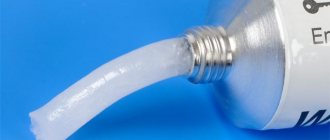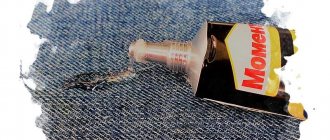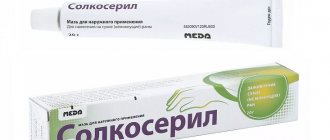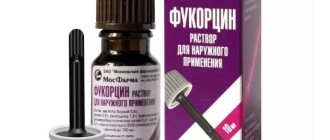Vaseline is a universal remedy that has a wide range of uses in different areas.
Widely popular in cosmetology and medicine. Finds its application in everyday life. It is in every home, because it is a very affordable and effective remedy that can solve many problems. What is Vaseline made from? Where and how to use it? Does it have contraindications and side effects? You will find out the answer to these and other questions from our article.
The product is a dense translucent mass without a pronounced odor. If you taste this ointment, you will not feel any special taste. She's tasteless.
What is Vaseline?
Chemists obtain petroleum jelly from oil. After its accidental discovery during oil drilling, it has been around for over 100 years.
Refined Vaseline
is a mineral oil that many companies market as a general-purpose skin care product.
The purity of Vaseline depends on the manufacturing process. Unrefined petroleum jelly may contain harmful ingredients, but refined petroleum jelly is usually safe. It is important to read the ingredient label and contact the manufacturer with any questions about the cleaning process.
Vaseline: composition and release form
Compound
These are petroleum (mineral) oils and solid paraffin substances.
Mineral oils are obtained during the refining of petroleum products. Paraffin substances are a waxy mixture of hydrocarbons with a branched or linear structure.
Release form
This ointment is suitable for external use only. Available in the form of an ointment in tubes and jars of 25, 50, 75 or 100 grams.
The color of the ointment can vary from translucent white to light yellow. Melts at temperatures above 27 degrees. When melted, it turns into a cloudy, odorless, oily liquid.
There are types:
- Medical.
- Cosmetic.
- Technological.
Benefits of Vaseline
Companies once marketed Vaseline as a miracle cure for everything from wrinkles to burns. While it cannot cure all skin conditions, it is a versatile and affordable skin care option.
Benefits of Vaseline include:
Acting as a skin barrier
The skin does not easily absorb Vaseline. This means that it is not actually a humectant, but a barrier that can keep dirt out and prevent moisture loss. People can try applying it to irritated skin before spending time outside in cold, dry, windy air. People with a cold can apply it to the skin near the nose to prevent irritation due to a runny nose or frequent wiping of the nose.
Preventing irritation
Chafing, which occurs when another part of the body or clothing rubs against the skin, causing irritation. This is especially true for people with eczema or dry skin. Some people develop a rash or broken skin due to irritation. Applying petroleum jelly to areas prone to chafing can help prevent this.
Treatment of diaper rash
Many babies develop skin rashes after sitting on wet diapers. Vaseline creates a moisture barrier that can reduce the risk of diaper rash. It may also soothe the skin and provide relief from existing wet diaper rash.
Preventing Peeling
Exfoliation of the skin may cause irritation. Vaseline can soothe irritation and help the skin heal. People can try applying it to dry, chapped lips or irritated eyelids in cold weather.
Treatment of eczema
Eczema is a chronic skin condition that causes irritation, itching and flaking. A 2022 study found that petroleum jelly may prevent eczema flare-ups. Scientists have concluded that frequently moisturizing the skin of newborns at high risk of eczema may prevent flare-ups. Vaseline, according to the study, was found to be particularly effective and more affordable than other options.
Brief characteristics of the drug
Vaseline was first obtained back in 1859 during experiments with oil.
The resulting product resembled the popular delicacy in appearance and consistency, and was therefore called oil jelly. But the inventor of the substance, chemist Robert Chesbrough, could not popularize it under this name, and therefore came up with another name for his brainchild, combining parts of the German and Greek words, which translated mean water and oil. This marketing ploy turned out to be more successful, as it quickly attracted public attention. A few years later, the scientist patented a new name, which not only has survived to this day, but has also become a household name. What is Vaseline made from, its physicochemical properties
Today there are two types of substances: natural and synthetic origin. The first is obtained from paraffin resins of deciduous trees after appropriate cleaning, bleaching, deodorizing and dyeing.
The substance does not have a structural formula, since it is a mixture of several components: mineral oil and paraffin hydrocarbons.
Natural Vaseline has an ointment-like, viscous structure that forms viscous threads. When applied in a thin layer to the surface, it is clearly visible. The substance does not smell of anything; when heated, it can emit a faint paraffin odor.
The melting point is from 27 to 60 °C, the liquid formed during heating is transparent, can be colorless or with a yellowish tint.
The substance can dissolve in ethers and chloroform, but not in water or ethanol. Combines well with all vegetable oils, except castor.
Vaseline has pronounced aseptic and hydrophilic properties: it is able to absorb and retain moisture. Emulsifies with great difficulty. During storage, a quality substance should not separate into fractions and release even the smallest particles of oil.
To produce synthetic petroleum jelly, a set of several components is used: ceresin, purified perfume oil and medical petroleum jelly. The ingredients are mixed, melted, and a certain amount of pure petrolatum is added to the resulting mixture to achieve viscosity and prevent oil separation.
The raw material for the artificial substance is waste from the wood processing industry or a special cosmetic substance. The physical characteristics of the synthetic substance are similar in quality to natural petroleum jelly; it is just as viscous, but differs in shorter threads.
The composition of the additives or the degree of purification of the substance depends on what Vaseline is needed for. Most often it is used in cosmetology, food industry, medicine and everyday life.
Vaseline benefit or harm for skin - considerations
Purified forms of Vaseline do not contain dangerous ingredients. Vaseline is one of the most popular commercial forms, and according to the Environmental Working Group (EWG), it helps counteract carcinogens and other dangerous ingredients. Unrefined petroleum jelly contains some potentially dangerous contaminants. A group of carcinogens called polycyclic aromatic hydrocarbons can cause cancer and damage reproductive organs. People who want to use Vaseline must buy it from a pharmacy. Homemade products containing petroleum jelly and products from unknown brands may contain harmful ingredients. Vaseline can also worsen skin conditions. The skin naturally forms a protective film after injury, which helps prevent further damage and infection. Vaseline interferes with the formation of this film. Although Vaseline can be used as a lubricant if there are no better options for this. Vaseline is also difficult to clean or rinse off after compared to water-based lubricants. This increases the chance of developing a bacterial infection. Vaseline can also clog pores. People with acne or sensitive skin should avoid using petroleum jelly on areas such as the face. Store it in a cool, dry place. Vaseline can also irritate the lungs, especially in large quantities. Very rarely, this irritation can cause pneumonia.
Contraindications and side effects
As with everything, when using this ointment, it is important to know when to stop and not to apply it in a generous layer, since such use can give a negative result instead of a protective and softening effect. If you lubricate the skin with copious amounts of Vaseline, glands may become clogged.
Occasionally, an allergic reaction to this ointment may occur in the form of pain and rashes.
Vaseline can be combined with other medications and used during pregnancy and lactation.
conclusions
Vaseline is an affordable, multi-use skin care product.
Vaseline is not a substitute for other skin care products, including a quality moisturizer. Its application may even worsen the condition of the skin, slowing down the healing time. People concerned about skin problems or interested in assessing the benefits and risks of Vaseline should consult a dermatologist. Vaseline is available in grocery stores, pharmacies, and online retailers.
The authors of another article suggest how to care for dry skin in winter.
Medicinal properties: what is Vaseline useful for?
Vaseline itself does not have any healing properties: it does not penetrate the layers of the dermis, does not pass into the systemic bloodstream and into the body. Its beneficial effect lies in another feature: since the product does not dissolve well and is not absorbed, after application to the surface of the skin it forms a thin film. This ability explains its healing effect.
The resulting film is quite dense; it does not allow any substances to pass onto the surface of the dermis, thereby protecting it from infection. Retains water contained in the skin, thereby preventing drying and peeling. Therefore, when used correctly, Vaseline helps the skin heal and promotes its faster recovery after various injuries.
In addition, the natural or synthetic product has a good ability to soften the skin. For this reason, it is actively used for cosmetic purposes.
But if used incorrectly, Vaseline can also have harmful effects. It can clog pores, and this, in turn, leads to the accumulation of sweat and sebum on the surface of the skin. Accordingly, if the drug is not removed in time, it can contribute to skin lesions.
Therefore, it is incorrect to say that it causes harm; in itself it is neutral. Its incorrect use is harmful.
Side effects
Vaseline is well tolerated in most cases, but the drug can cause allergic reactions at the sites of application in particularly sensitive patients. Undesirable symptoms appear in the form of redness, irritation or rash.
Drug interactions
The substance is practically neutral, since it almost does not react with other components of external products. Clinical data and observations have not yet provided evidence of negative interaction reactions or distortion of therapeutic actions.
Contraindications
Individual skin reaction.
Vaseline medical use
Medical Vaseline is used as an ointment base and an emollient that is poorly absorbed by the skin; in emollient creams for topical use they are used in a concentration of 10-30%, in emulsions - 4-25%, ointments - up to 100%. Included in non-adhesive medical gauze dressings containing API. Medical Vaseline is widely used
in the production of cosmetics and some food products.
Literature
- Zhoglo F., Vozniak V., Popovich V. et al. Excipients and their use in the technology of dosage forms: A reference guide. - Lvov, 1996;
- Sarafanova L.A. Food additives: Encyclopedia. - St. Petersburg, 2004;
- Rowe PC, Sheskey PJ, Owen SC Handbook of Pharmaceutical Excipients. — London-Chicago, 2006.
^Top
Wound healing agent
Unfortunately, no one is immune from injury. Once I was cooking at the dacha and severely cut my hand, almost to the bone. It was urgent to stop the bleeding. I washed the wound well and then applied a thick layer of Vaseline to it. This stopped the bleeding. She covered the top with a thick bandage and wore it without taking it off for three days.
Then she changed the bandage, again smearing the wound with Vaseline, and kept it on her hand for another three days. The wound healed quickly, and after a week all that was left was memories. The skin is smooth, without scars. Now Vaseline is always present in my first aid kit as an emergency remedy.
It also helps with burns. My sister was removing a pot of boiling water from the stove when she slipped, dropped the container and severely scalded her feet. The burns were serious and were treated with various means. I advised her to use Vaseline. Every three days she lubricated her legs with a significant layer of Vaseline, and within 12 days there was no trace of the burns.
This product is also good for the face.
You can do “wet makeup” and get great shots. Apply a little onto the eyelid and apply shadow on top. Don't worry because the skin around your eyes is very delicate. This product will not harm the skin around the eyes.
If the eyebrows stubbornly do not want to fit beautifully, and there is no product for this stage of care, then you can use Vaseline. The main thing is not to use too much.
It can also be used as a makeup remover. Of course, it is always better to use the means that are intended for this, but this can also be a way out of the situation.
Yes, in fact, you can also smear it on your lips. First of all, you will protect your lips from the harmful influences of the external environment, and also make them more attractive. Definitely get rid of roughness and uneven surfaces.
Areas of application and what Vaseline is used for
The scope of use of Vaseline is extremely wide: in addition to medicine, it is used in cosmetics as a food additive, and is also in demand in industry and is indispensable in everyday life for solving various needs. In accordance with this, a product of varying degrees of purification is used.
What is medical Vaseline used for?
The drug is manufactured in accordance with the highest requirements. For medical purposes, white Vaseline is used, which meets the highest requirements. It is used both to soften the skin (before inserting medical cups) and to treat medical instruments to facilitate insertion into the natural orifices of the body. Medical Vaseline is used to lubricate enema tips and gas tubes. Adjacent tissues are also treated with it to protect from injury during the procedure.
If you need to apply Vaseline to the skin, then it is applied to the previously cleansed dermis. The dosage regimen and number of procedures are determined in accordance with the indications and form of the drug. Vaseline is especially helpful for the face and skin of the hands after the negative effects of external factors: strong wind, sharp temperature fluctuations, frost and bright sun.
Vaseline for cosmetic purposes
In the beauty industry, a medical drug or a drug specially developed for this purpose is used. Cosmetic petroleum jelly may not be as thoroughly purified as medical grade petroleum jelly, but it is also of high quality. In addition, depending on its purpose, various oils, fragrances and other components that have a beneficial effect on the skin are added to it.
The popularity of Vaseline in cosmetology is easily explained: when used correctly, it does not harm the skin and combines well with other substances. At the same time, it promotes the healing of superficial damage, softens, and preserves moisture. It is allowed to smear the face with Vaseline or other parts of the body in pure form or mixed with other components.
In addition, the substance is excellent for home or salon cosmetology. Many different formulations can be prepared based on Vaseline, depending on the purpose of use. Such masks for the face, hands and décolleté with Vaseline help get rid of many skin defects: hyperpigmentation, peeling, irritation. Vaseline is used against wrinkles due to its ability to soften and moisturize the skin.
The drug is also useful for men: it can successfully replace shaving cream.
How to make Vaseline at home
Despite the cheapness, availability and large selection of Vaseline in pharmacies, it is not necessary to buy it. Those who do not like store-bought products often do without it, because the substance can be made independently. Those who want to create a useful product with their own hands can easily use recipes that are widely available. Here's just one of them:
200 ml of any plant. Boil the oil slowly for 20 minutes, then add beeswax (50 g) and keep on fire for the same amount. Add crushed aloe (3-4 leaves), boil for the same time. Cool the resulting mass, strain, and pour into a container.
Properties of Vaseline in everyday life
Well, for example, it adds shine to things made of leather or leatherette that have lost it. Apply and after a few minutes simply wipe off.
How does he deal with stuck lightning? Some people use paraffin for this, but Vaseline also glides well and will help solve this problem. It will work similarly with rusty buttons and other sticking mechanisms.
You can also polish furniture with it. And the beauty is that Vaseline will repel dust.
Have you encountered problems with your nail polish drying? Have you tried to open it with your teeth? We, too. However, it is enough to lightly lubricate the inside of the cap with Vaseline and this problem no longer bothers us.
Agree that these methods of its application are interesting. In addition, we have mentioned some of the properties of Vaseline. If you want, we will describe its properties in more detail.
Composition of medical Vaseline
Medical Vaseline
, Petrolatum (USP), Vaselinum flavum (Ph Eur), Yellow soft paraffin (BP), Yellow petrolatum (JP) - a purified mixture of semi-solid, solid and liquid hydrocarbons with the general formula СnH2n +2. The composition of medical petroleum jelly is a mixture of hydrocarbons consisting mainly of branched and unbranched chains, it may contain some cyclic alkanes and aromatic molecules with paraffin side chains. According to the European Pharmacopoeia (EP) 2005 and US Pharmacopoeia (F) 28. Medical petroleum jelly may contain a certain stabilizer (antioxidant, eg butyl hydroxytoluene, butyl hydroxyanisole or α-tocopherol), which is noted when labeling. Introduced into pharmacy in 1876.
V. is obtained during oil refining from a semi-solid residue after steam or vacuum distillation. V. purification is carried out by hydrogenation under high pressure or treatment with sulfuric acid after filtration through adsorbents. A specific antioxidant may be added to the finished product.
Medical Vaseline is a homogeneous ointment-like mass, stretches in threads, odorless, white or yellow, fluoresces slightly in daylight. White Vaseline in composition and properties corresponds to yellow, only more completely freed from coloring substances (using the bleaching method). Thanks to the composition of medical Vaseline, the substance applied to a glass plate forms an even film that does not slip or crack. Drop point - 40-60 ° C (EF), melting point - 38-60 ° C, density at 60 ° C - 0.815-0.880 (US F), refractive index = 1.460-1.474; practically insoluble in acetone, ethanol, hot and cold 95% ethanol, glycerin and water; soluble in gasoline, chloroform, ether, hexane and most volatile and non-volatile oils. Dynamic viscosity is not lower than 2.5 at 60 ° C (according to Engler); rheological properties are determined by the ratio of straight to branched chains and cyclic components of the mixture. V. contains a relatively large amount of branched and cyclic hydrocarbons compared to paraffin, which makes it an ideal ointment base.
Due to its composition, medical Vaseline is saponified by alkali solutions, does not change under the action of concentrated acids, does not oxidize and does not become bitter in air. Mixes in all proportions with fatty oils (except castor) and fats. When kindled, it forms a homogeneous, transparent, slightly fluorescent liquid. Medical Vaseline is a stable product due to the non-reactive nature of its components; Stability problems arise from the presence of impurities that oxidize when exposed to light, causing the formation of undesirable odors. The degree of oxidation of petrolatum varies depending on its purity and the presence or absence of an antioxidant stabilizer. Therefore, it is recommended to heat it very much (not > 70 ° C until fluidity is achieved). Medical Vaseline practically does not react with the active ingredients attached to it.
Instructions for use and dosage
Medical Vaseline is used topically on certain areas of the skin. Apply a small amount of the product to the affected area and rub in with massage movements, however, caution should be exercised on sensitive and thin areas (lips, for example). The drug is also used for applications. Before applying Vaseline, the skin must be cleaned of contaminants, and after use, wash your hands thoroughly with warm water and hygiene products. Do not allow the product to come into contact with mucous membranes or eyes; otherwise, rinse the surface with plenty of water.








